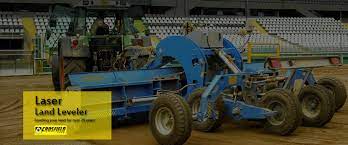Understanding Laser Land Leveling Technology
Laser land leveling, a groundbreaking agricultural technique, ensures the land surface is smoothed to within ±2 cm of its average elevation. Utilizing state-of-the-art laser-equipped drag buckets, this method guarantees unparalleled precision in land leveling. By adjusting fields to maintain a slight slope of 0 to 0.2%, precision land leveling is transforming agricultural landscapes.
How Laser Land Leveling Works
The core of this technology lies in a laser transmitter that emits a beam caught by a receiver mounted on the leveling bucket. A control panel on the tractor interprets signals from the receiver to adjust the hydraulic control valve accordingly, either raising or lowering the bucket to redistribute soil as needed. Essential components include:
- 4-Wheel Tractor: Essential for dragging the leveling bucket, suitable tractors range from 30 to 500 hp. Optimal performance is found in 4-wheel drive models with power shift transmission.
- Drag Bucket: This can be mounted via 3-point linkage or pulled by the tractor’s drawbar, with the latter preferred for easier hydraulic system connection.
- Laser Transmitter and Receiver: Mounted on a tripod, the transmitter allows unobstructed laser sweep over the field, while the receiver, attached to the drag bucket, sends position signals to the control box.
- Control Panel and Hydraulic Control System: Processes receiver signals to guide the drag bucket and manages oil flow for bucket movement, ensuring precise leveling.
Types of Laser Levelers
There are several types of laser land Levelers, each with its own characteristics and applications. Some of the most common types are :
- Manual Lasers Land Leveling: Require manual setup, achieving accuracy up to 1 cm at 100m.
- Semi Self-Leveling Lasers: Automatically adjust within a certain range, maintaining at least 1 cm accuracy at 100m.
- Fully Self-Leveling Lasers: Automatically maintain level within a specified range, offering the highest ease of use with accuracy up to 2.5 mm at 100m.
- Split-Beam Lasers: Emit both horizontal and vertical beams for establishing level and plumb reference lines.
Benefits of Laser Land Leveling
Laser land leveling is not just about leveling the ground; it’s about enhancing the entire agricultural ecosystem. The uniform soil moisture distribution it facilitates leads to improved germination, crop yield, and input efficiency. Other benefits include:
- Enhanced irrigation efficiency and nutrient retention.
- Uniform seedling placement for higher yields.
- Significant reduction in weed, pest, and disease incidence.
- Recovery of 3 to 4% additional land and operational efficiency boosts.
- Reduced consumption of seeds, fertilizers, chemicals, and fuel.
- Facilitated movement of agricultural machinery across fields.
Laser Leveling Procedure
Achieving the perfect level involves several critical steps, starting with soil redistribution from high to low points for cost-effectiveness. The procedure includes:
- Plowing: Preferably from the center outwards when soil moisture is optimal.
- Topographic Survey: Identifying high and low spots to plan soil redistribution.
- Field Leveling: Positioning the laser-controlled bucket at the field’s mean height and adjusting the cutting blade for precise soil removal.

